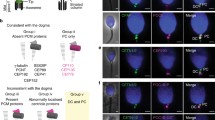Abstract
The human oviduct is lined with a simple columnar epithelium composed of ciliated cells and secretory cells. Primary cilia or solitary cilia usually extend from the apical surface of the secretory cells. The axoneme of the primary cilia is composed of nine peripheral microtubule doublets (9 + 0 pattern) that lack dynein arms and nexin links. Displacement of peripheral doublets to the central region, which is suggested to be attributable to the lack of nexin links, is one of the distinctive features of oviductal primary cilia. The basal body that extends the primary cilium connects to its paired centriole by the striated connector. The basal body is associated with the accessory structures, such as alar sheets, basal feet, and striated rootlets. Several basal feet project laterally from the basal body. The cap of the basal foot serves as the microtubule organizing center. Several striated rootlets radiate from the basal body toward the nucleus. The basal body, the paired centriole, and the basal body-associated structures are considered to play important roles in the stabilization and fixing of the cilium in the proper position on the apical cell surface.
Similar content being viewed by others
References
Satir P, Christensen ST (2007) Overview of structure and function of mammalian cilia. Annu Rev Physiol 69:377–400
Tanaka K, Sutani A, Uchida Y, Shimizu Y, Shimizu M, Akita M (2007) Ciliary ultrastructure in two sisters with Kartagener’s syndrome. Med Mol Morphol 40:34–39
Hagiwara H, Ohwada N, Aoki T, Takata K (2000) Ciliogenesis and ciliary abnormalities. Med Electron Microsc 33:109–114
Hagiwara H, Ohwada N, Takata K (2004) Cell biology of normal and abnormal ciliogenesis in the ciliated epithelium. Int Rev Cytol 234:101–141
Alieva IB, Vorobjev IA (2004) Vertebrate primary cilia: a sensory part of centrosomal complex in tissue cells, but a “sleeping beauty” in cultured cells? Cell Biol Int 28:139–150
Wheatley DN (2005) Landmarks in the first hundred years of primary (9+0) cilium research. Cell Biol Int 29:333–339
Michaud EJ, Yoder BK (2006) The primary cilium in cell signaling and cancer. Cancer Res 66:6463–6467
Singla V, Reiter JF (2006) The primary cilium as the cell’s antenna: signaling at a sensory organelle. Science 313:620–633
Blacque OE, Leroux MR (2006) Bardet-Biedl syndrome: an emerging pathomechanism of intracellular transport. Cell Mol Life Sci 63:2145–2161
Hagiwara H, Kano A, Aoki T, Ohwada N (2000) Immunocytochemistry of the striated rootlets associated with solitary cilia in human oviductal secretory cells. Histochem Cell Biol 114:205–212
Hagiwara H, Harada S, Maeda S, Aoki T, Ohwada N, Takata K (2002) Ultrastructural and immunohistochemical study of the basal apparatus of solitary cilia in the human oviduct epithelium. J Anat 200:89–96
Barberini F, Makabe S, Correr S, Luzi A, Motta PM (1994) An ultrastructural study of epithelium differentiation in the human fetal fallopian tube. Acta Anat (Basel) 151:207–219
Odor DL, Blandau RJ (1985) Observations on the solitary cilium of rabbit oviductal epithelium: its motility and ultrastructure. Am J Anat 174:437–453
Gilula NB, Satir P (1972) The ciliary necklace. A ciliary membrane specialization. J Cell Biol 53:494–509
Yamamoto M, Kataoka K (1986) Electron microscopic observation of the primary cilium in the pancreatic islets. Arch Histol Jpn 49:449–457
Paintrand M, Moudjou M, Delacroix H, Bornens M (1992) Centrosome organization and centriole architecture: their sensitivity to divalent cations. J Struct Biol 108:107–128
Wheatley DN, Wang AM, Strugnell GE (1996) Expression of primary cilia in mammalian cells. Cell Biol Int 20:73–81
Eley L, Yates LM, Goodship JA (2005) Cilia and disease. Curr Opin Genet Dev 15:308–314
Nonaka S, Shiratori H, Saijoh Y, Hamada H (2002) Determination of left-right patterning of the mouse embryo by artificial nodal flow. Nature (Lond) 418:96–99
Qin H, Diener DR, Geimer S, Cole DG, Rosenbaum JL (2004) Intraflagellar transport (IFT) cargo: IFT transports flagellar precursors to the tip and turnover products to the cell body. J Cell Biol 164:255–266
Deane JA, Cole DG, Seeley ES, Diener DR, Rosenbaum JL (2001) Localization of intraflagellar transport protein IFT52 identifies the transition fibers of the basal body as the docking site for IFT particles. Curr Biol 11:1586–1590
Christensen ST, Pedersen LB, Schneider L, Satir P (2007) Sensory cilia and integration of signal transduction in human health and disease. Traffic 8:97–109
Boisvieux-Ulrich E, Sandoz D (1991) Determination of ciliary polarity precedes differentiation in the epithelial cells of quail oviduct. Biol Cell 72:3–14
Hagiwara H, Aoki T, Ohwada N, Fujimoto T (1997) Development of striated rootlets during ciliogenesis in the human oviduct epithelium. Cell Tissue Res 290:39–42
Shiba D, Takamatsu T, Yokoyama T (2005) Primary cilia of inv/inv mouse renal epithelial cells sense physiological fluid flow: bending of primary cilia and Ca2+ influx. Cell Struct Funct 30:93–100
Nauli SM, Alenghat FJ, Luo Y, Williams E, Vassilev P, Li X, Elia AE, Lu W, Brown EM, Quinn SJ, Ingber DE, Zhou J (2003) Polycystins 1 and 2 mediate mechanosensation in the primary cilium of kidney cells. Nat Genet 33:129–137
Liu W, Murcia NS, Duan Y, Weinbaum S, Yoder BK, Schwiebert E, Satlin LM (2005) Mechanoregulation of intracellular Ca2+ concentration is attenuated in collecting duct of monocilium-impaired orpk mice. Am J Physiol Renal Physiol 289:F978–F988
Critoph FN, Dennis KJ (1977) Ciliary activity in the human oviduct. Br J Obstet Gynaecol 84:216–218
Lyons RA, Djahanbakhch O, Mahmood T, Saridogan E, Sattar S, Sheaff MT, Naftalin AA, Chenoy R (2002) Fallopian tube ciliary beat frequency in relation to the stage of menstrual cycle and anatomical site. Hum Reprod 17:584–588
Fredericks CM (1986) Morphological and functional aspects of the oviductal epithelium. In: Siegler AM (ed) The Fallopian tube. Futura, Mount Kisco, pp 67–80
Author information
Authors and Affiliations
Corresponding author
Rights and permissions
About this article
Cite this article
Hagiwara, H., Ohwada, N., Aoki, T. et al. The primary cilia of secretory cells in the human oviduct mucosa. Med Mol Morphol 41, 193–198 (2008). https://doi.org/10.1007/s00795-008-0421-z
Received:
Accepted:
Published:
Issue Date:
DOI: https://doi.org/10.1007/s00795-008-0421-z




